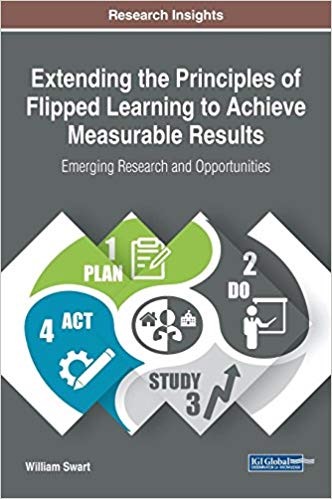Date Reviewed: April 15, 2020
As higher education continues to grapple with expanding online coursework in meaningful ways, faculty must confront a perennial question: how can online coursework mirror the rigor of in-person classes while preserving the flexibility that makes online learning attractive to students? In Extending the Principles of Flipped Learning to Achieve Measurable Results: Emerging Research and Opportunities, William Swart argues that flipped learning has the potential to balance these demands by winnowing the transactional distance, a barrier to student engagement, that is common in traditional coursework.
In traditional learning, a lecture typically occurs in class and homework extends beyond the classroom; conversely, flipped learning requires students to study course material at home, including recorded lectures, before engaging in collaborative, problem-solving activities in class. By flipping the traditional model of higher education, flipped learning allows students to invest more deeply in their coursework while simultaneously receiving feedback and peer support in class.
While flipped learning may be alluring, enacting such a dramatic reordering requires resources, knowledge, and tools that most faculty do not possess. Written in a straightforward, practical style, Swart’s text provides a viable throughway for faculty members hoping to enact a flipped classroom.
Swart begins his exploration of the concept by reviewing the proliferation of online coursework and noting the near-universal agreement among university faculty regarding the disparity of quality in online learning versus face-to-face learning. As an antidote to this pattern, Swart touts the considerable benefits that flipped learning affords students, instructors, and college administrators. Following this introductory material, the text grounds the Plan-Do-Study-Act (P-D-S-A) cycle as the primary vehicle for introducing, executing, and maintaining a flipped classroom. This cycle, originating from business and management, ensures that meaningful learning occurs throughout a new intervention, rather than relying solely on outcome data to judge the effectiveness of an intervention.
The heart of the text unpacks each step of the PDSA cycle and its use in a flipped classroom, offering practical advice and data to support those wishing to use the flipped model. This occurs through direct discussion of the model and an embedded case study that illustrates core concepts. Before closing with an exploration of possible future research, Swart also includes candid discussion of the challenges—both anticipated and unanticipated—that flipped learning often produces. As Swart notes, while there is positive evidence regarding student preferences, achievement, and satisfaction concerning flipped learning, there is a paucity of research documenting its role in promoting other desirable values in students.
This text adds to a growing body of research explicating the promise of flipped learning within K-12 and higher education. Particularly for faculty members in theological education or religious studies in a liberal arts setting, this text provides short-term and lasting benefits. Swart’s thorough unpacking of flipped learning delivers a robust catalog of research-based, practical advice for enacting this model. Perhaps most valuable for these faculty is the opportunity for students to engage with weighty ideas in a collaborative manner after having initial, independent preparation.
